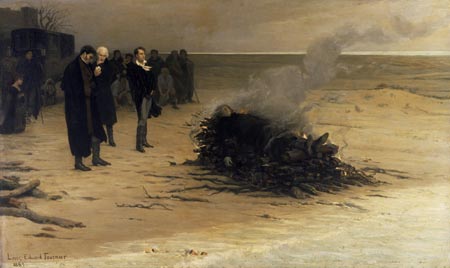https://en.wikipedia.org/wiki/Percy_Bysshe_Shelley#Death wrote:
<<On 8 July 1822, less than a month before his thirtieth birthday, Percy Bysshe Shelley drowned in a sudden storm on the Gulf of Spezia while returning from Leghorn (Livorno) to Lerici in his sailing boat, the Don Juan. The name Don Juan, a compliment to Byron, was chosen by Edward John Trelawny, a member of the Shelley–Byron Pisan circle. However, according to Mary Shelley's testimony, Shelley changed it to Ariel, which annoyed Byron, who forced the painting of the words "Don Juan" on the mainsail.
Some believed his death was not accidental, that Shelley was depressed and wanted to die; others suggested he simply did not know how to navigate. More fantastical theories, including the possibility of pirates mistaking the boat for Byron's, also circulated. Two other Englishmen were with Shelley on the boat. One was a retired naval officer, Edward Ellerker Williams; the other was a boatboy, Charles Vivien. The boat was found ten miles offshore, and it was suggested that one side of the boat had been rammed and staved in by a much stronger vessel. However, the liferaft was unused and still attached to the boat. The bodies were found completely clothed, including boots.
Shelley's body was washed ashore and later, in keeping with quarantine regulations, was cremated on the beach near Viareggio. In Shelley's pocket was a small book of Keats' poetry. Upon hearing this, Byron said of Shelley: "I never met a man who wasn't a beast in comparison to him". An 1889 painting by Louis Édouard Fournier, The Funeral of Shelley, contains inaccuracies. In pre-Victorian times it was English custom that women would not attend funerals for health reasons. Mary Shelley did not attend but was featured in the painting, kneeling at the left-hand side. Leigh Hunt stayed in the carriage during the ceremony but is also pictured. Also, Trelawny, in his account of the recovery of Shelley's body, records that "the face and hands, and parts of the body not protected by the dress, were fleshless," and by the time that the party returned to the beach for the cremation, the body was even further decomposed. In his graphic account of the cremation, he writes of Byron being unable to face the scene, and withdrawing to the beach.
Shelley's ashes were interred in the Protestant Cemetery in Rome, near an ancient pyramid in the city walls. His grave bears the Latin inscription, Cor Cordium (Heart of Hearts), and, in reference to his death at sea, a few lines of "Ariel's Song" from Shakespeare's The Tempest: "Nothing of him that doth fade / But doth suffer a sea-change / Into something rich and strange." A memorial was eventually created for Shelley at the Poets' Corner at Westminster Abbey, along with his old friends Lord Byron and John Keats.>>
 Eclipse over the Gulf of Poets
Eclipse over the Gulf of Poets
